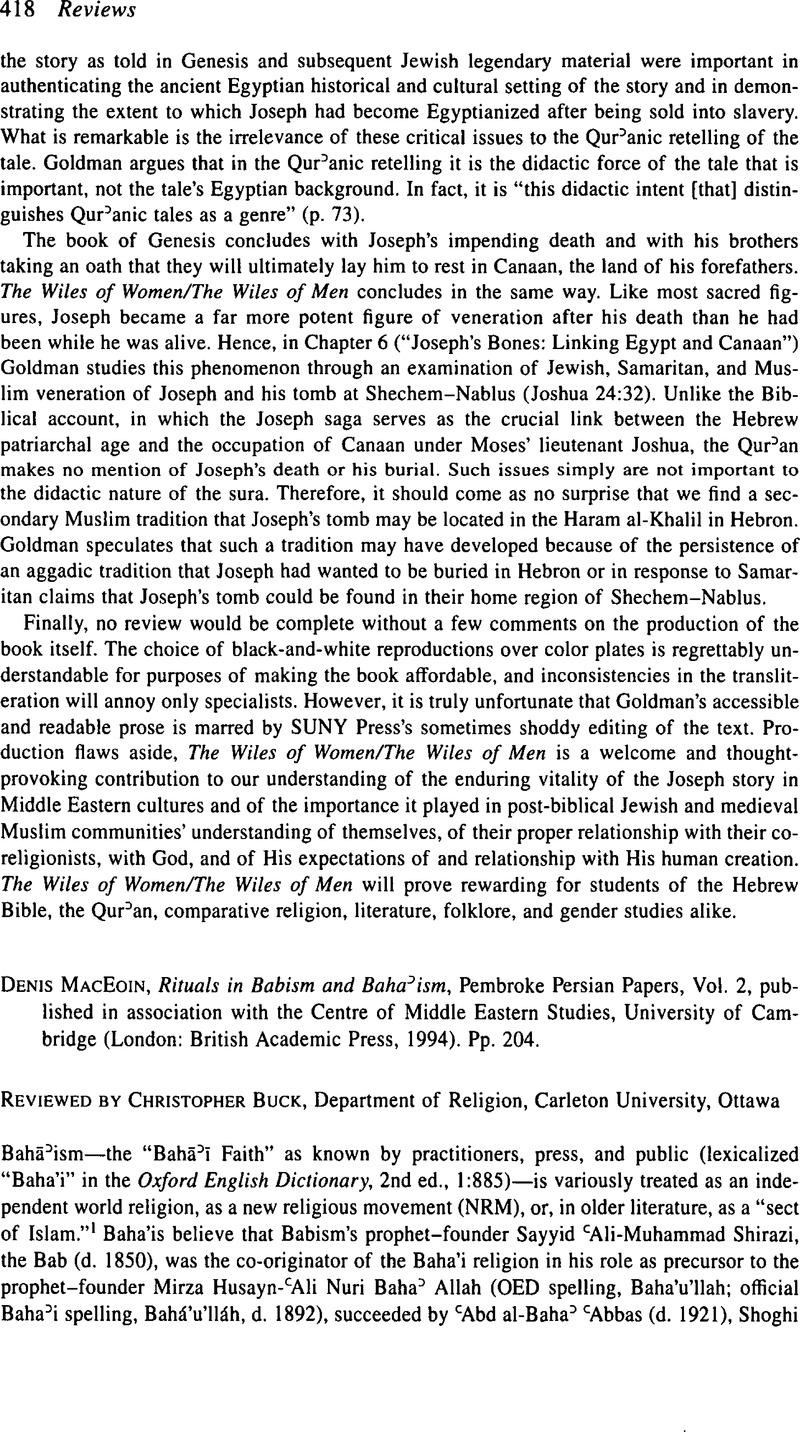Article contents
Denis MacEoin, Rituals in Babism and Bahaʾism, Pembroke Persian Papers, Vol. 2, published in association with the Centre of Middle Eastern Studies, University of Cambridge (London: British Academic Press, 1994). Pp. 204.
Published online by Cambridge University Press: 23 April 2009
Abstract

- Type
- Book Reviews
- Information
- Copyright
- Copyright © Cambridge University Press 1996
References
1 I discussed its precipitous break from Islam—mediated by the Babi religion—in a recent monograph: Buck, Christopher, Symbol and Secret. Qur'an Commentary in Bahā'u'llāh's Kitāb-i Īqān, Studies in the Bābi and Bahā'ī Religions, Vol. 7 (Los Angeles: Kalimát Press, 1995).Google Scholar
2 Jan Platvoet, “Ritual in Plural and Pluralist Societies: Instruments for Analysis,” in Pluralism and Identity: Studies in Ritual Behaviour, ed. idem and Toorn, Karel van der (Leiden: E. J. Brill, 1995), 25–51Google Scholar.
3 Buck, , Symbol and Secret, 42–45.Google Scholar
4 Effendi, Shoghi, God Passes By (Wilmette: Bahā'ī Publishing Trust, 1974 [1944]), 350.Google Scholar
5 From a letter written on behalf of Shoghi Effendi, 24 06 1949Google Scholar, cited in Momen, Wendi, A Basic Bahā'ī Dictionary (Oxford: George Ronald, 1989), 198.Google Scholar
6 Bahā'u'llāh, , The Kitāb-i-Aqdas: The Most Holy Book. Translated under the auspices of The Universal House of Justice (Haifa: Bahā'ī World Centre, 1992), 60Google Scholar. Upon examination of MacEoin's source, ʿAbd al-Bahaʾ's statement turns out to be an address (khiṭābī) presumably to an individual believer, rather than a written, authoritative “tablet” (lawḥī), although the latter cannot be ruled out. No “cure” is promised, but the “influence shall be powerful” (![]() ast) if performed “with absolutedevotion, with a pure heart and pure intention and with attraction of the spirit” (bi-tavvajuh-i tāmm va qalb va niyyat-i pāk va injiẕāb-i rūḥ). Mazandarani, Fazil, Amr va Khalq (Bahā'ī-Verlag, 1986), 68–69 (MacEoin's translation; my transliteration)Google Scholar. I can scarcely conceive of such a “cure” as a “ritual” or even as a “semi-ritual” as its observance is now rarely, if ever, practiced among Baha'is.
ast) if performed “with absolutedevotion, with a pure heart and pure intention and with attraction of the spirit” (bi-tavvajuh-i tāmm va qalb va niyyat-i pāk va injiẕāb-i rūḥ). Mazandarani, Fazil, Amr va Khalq (Bahā'ī-Verlag, 1986), 68–69 (MacEoin's translation; my transliteration)Google Scholar. I can scarcely conceive of such a “cure” as a “ritual” or even as a “semi-ritual” as its observance is now rarely, if ever, practiced among Baha'is.
7 In terms of group dynamics, Jan Snoek's hypothesis may be instructive here: “The more the groups from which one wishes to distinguish oneself (the out-groups), are similar to one's own group (the ingroup), the more rigidly will the distinguishing characteristics be formulated, and the more attention will be paid to these characteristics.” Snoek, Jan, “Similarity and Demarcation,” in Pluralism and Identity, 53.Google Scholar
8 See note 6.
- 3
- Cited by


